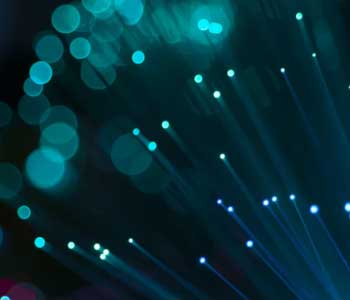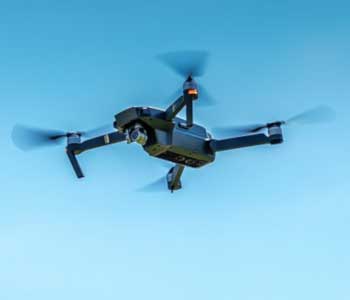Since the 1980s, many of the world’s brightest minds have been hard at work in creating a truly interconnected world. As technology has grown, so has the need for this connection to support faster transfer rates and better stability.
This is the main motivation for the development of a technology called quantum internet. Using principles of quantum mechanics straight out of science fiction, quantum internet allows for faster and more secure data transfer across larger distances. What possible role can drones play in making quantum internet a reality?
What is the quantum Internet?

Just as with standard internet, the main purpose of the quantum internet is to provide a network that allows for rapid and long-distance data exchange. The main medium of exchange in this case are photons – the same ones we are already transmitting across underwater fiber optic cables. In the case of quantum internet, the photons are transmitted through quantum satellites.
What makes the quantum internet unique is that it transmits information in the form of qubits. These are vastly different from the standard bits that we use today.
For background, the information in bits is encoded as either 1 or 0. Through unique combinations of bits, specific information can be encoded and transmitted in digital form. Encoding of information into bits has been the backbone of data transfer through the Internet for the last few decades.
Quantum internet changes things up massively. The term is derived from the use of concepts of quantum physics – a very unusual and innovative approach. Instead of standard bits, information transmitted through the quantum internet is in the form of qubits.
In qubits, information is encoded in a quantum state. To put it simply, it is in a state that is neither 1 nor 0. It is more accurately described as being both. The real state of the qubits is revealed only upon observation, or once it has been accessed or measured. This harkens to the concept of quantum superposition, more commonly demonstrated in the example of Schrodinger’s cat.
How is quantum Internet better?
To better understand why so much effort is being poured into developing the quantum Internet, we must look at it under the context of its two major benefits – security and speed.
Security is a hallmark of quantum Internet technology. This is especially important in the modern era when data sensitive to national security, the economy, and the inner workings of private companies are transmitted billions of times each day over the Internet. Even the latest encryption technologies are inferior to the promise that quantum Internet offers.
Recall that qubits are in a state of superposition when they are transmitted. Since the qubits are neither 1 nor 0, they do not translate to any meaningful data before they are accessed. However, just the mere act of looking at qubits changes their state. This is an irreversible process – a digital thumbprint that information has been accessed by someone somewhere.
This unique property of qubits is vital for ensuring that sensitive information is not intercepted or hacked. While hacking of qubits is still possible, it can no longer be done in means that will remain undetected. In simple terms, qubits make it impossible for anyone to eavesdrop on a conversation happening across the quantum Internet. It also means that qubits cannot be copied or amplified, which can be considered both a good thing and a bad thing.
Although qubits are still transmitted as photons, the quantum Internet has a unique speed advantage. This is possible through the concept of entanglement. When two qubits interact, they can become entangled. When this relationship has been established, any change to one of the qubits results in a similar change to the other. This is possible even without any physical communication between the two particles.
With linked qubits, information can be transferred across large distances without the need for a physical network. Not only does this reduce the demand for a physical infrastructure but also reduces latency in information exchange. This also makes the conversation virtually impossible to intercept.
The current limitation of quantum Internet technology
If quantum Internet is so great, then why don’t we have it yet? Among the hurdles that the technology still needs to overcome, the major one relates to signal attenuation.
While quantum networks that use fiber optic cables already exist, the primary goal is to create such a network using satellites. However, the limitation of this approach is that quantum signals naturally deteriorate when sent over the atmosphere. This means that current quantum networks are limited to a scope of just a few kilometers.
To expand the size of a quantum network, repeaters need to be put in place. This allows for the exchange of entangled qubits between distant nodes in a network. However, creating an entire network of quantum repeaters is an expensive matter. The reliability of this technology is yet to be fully understood at this point, making it impractical to jump into infrastructure development.
How drones can create a quantum internet network

The use of drones to help create a quantum network by researchers in Nanjing University was detailed in a paper published in the Physical Review Letters journal. In the study, two airborne drones essentially acted as repeaters, allowing two nodes to exchange qubits and form an entanglement.
In the experimental setup, two drones were stationed 200 meters apart and 400 meters away from a network node. This meant that the nodes were separated by 1 kilometer in total.
The idea for the experiment was to use the drones as repeaters, effectively reducing the distance over which quantum signals need to be transmitted. Positioning the drones at high altitudes also reduced the probability of the signals being interrupted or weakened due to diffraction.
According to the results, a quantum signal emitted by one drone had 25% reception by the node closest to it, while the farther node only received 4% of the signal. This emphasizes how effective drones can be as sources of quantum signals. However, it also highlights the massive losses in quantum signals when they are transmitted via drones.
At its current state, the attenuation of quantum signals makes drone-aided quantum networks less than feasible compared to short-range signal transmission. A loss of 75% or more of the original signal is simply unacceptable, especially when critical and time-sensitive information is being transmitted. However, the value proposition of drones as network repeaters is too compelling for the concept to not be further explored.
With drones, quantum networks can adapt to changing needs and can be used to create custom quantum mesh networks. This is particularly valuable in the context of quantum entanglement, where entangled qubits can continue to interact with each other even in the absence of a physical network. Compared to fixed receivers and quantum satellites, drones are much less expensive and can be deployed at a moment’s notice.
The biggest benefit of using drones is that is an easily scalable technology. Should drones be proven as reliable repeaters for quantum signals, this single development could help accelerate the progress of the quantum Internet. Perhaps a future where a fleet of drones gives way to rapid information transfer is not too far off.
Final thoughts
The whole concept of quantum Internet is intriguing. While it undeniably has good potential, perhaps we should temper our expectations of how much it will affect our daily lives. Will standard Internet be replaced entirely by quantum Internet? While this is theoretically possible, this is not the most likely outcome. At best, we can expect these two types of Internet to exist alongside each other.
Research on the use of drones to aid quantum Internet is still in the early stages, but it certainly shows a lot of promise. This is the kind of technology we’ll be keeping an eye on for the next couple of years. The idea of drones as signal repeaters can have a massive impact on the reach of Internet services – quantum or otherwise.
